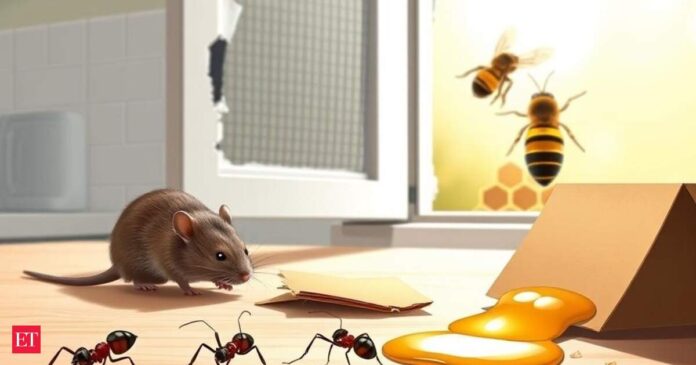Pest control begins with your home’s exterior. “Ground cover, shrubs, and mulch encourage pest activity,” says Richard Cooper, Ph.D., an entomologist and owner of R Cooper Consulting in Yardley, Pennsylvania. “Make sure they’re not touching your foundation; they can be an express lane for bugs.”
Ants are the common invader
Ants are among the most frequent household pests. Of the 700 species in the US, about 25 commonly enter homes, according to Jim Fredericks, Ph.D., of the National Pest Management Association. Warm weather or heavy rain can drive ants indoors in search of food and shelter.
How to eliminate them: Skip traditional sprays like Raid, which contain pyrethroids that may worsen infestations. Instead, wipe ants with soapy water and use bait stations. “Ants take the poison back to the nest, killing the colony,” Fredericks explains. Choose bait with both sweet and protein-based attractants for best results.
Prevention: Seal cracks, install weather stripping, and keep your kitchen crumb-free. Wipe sticky containers and clean up spills immediately. Natural remedies like vinegar or peppermint oil are often promoted online, but Cooper says these lack rigorous testing and may not be effective.
Bees, wasps, and hornets
Pollinators play a vital role outdoors, but nesting near a home can be dangerous.How to remove them: First, identify the insect species, like yellow jackets or Africanized bees are aggressive and should be handled by professionals. If it’s safe, spray nests at dusk when activity is low.
Prevention: Seal cracks early in spring before nests form, and repair screens on windows and vents.
Moths and pantry pests
Clothes moth larvae destroy fabrics, while pantry moths infest dry goods like cereal and flour.
What to do: Wash or dry-clean fabrics, or freeze items for four days to kill larvae and eggs. For pantry moths, discard infested food and thoroughly clean cupboards. Avoid mothballs; they’re ineffective and potentially harmful.
Flies and Roaches
Houseflies carry more than 100 pathogens, including Salmonella. For fruit flies, create traps using apple cider vinegar and dish soap. Roaches, which can trigger allergies, require gel baits placed under appliances. Persistent infestations call for professional treatment.
Wood-destroying insects
Termites, carpenter ants, and carpenter bees can compromise a home’s structure. Matt Frye of Cornell University recommends yearly inspections, especially in damp areas like basements. “Signs include mud tubes, discarded wings, and wood shavings,” Frye says. DIY treatments aren’t recommended; these pests require licensed professionals.
Rodents and wildlife
Mice can squeeze through holes the size of a dime, chewing wires and spreading hantavirus. Snap traps or catch-and-release traps baited with peanut butter work best. Seal entry points with steel wool and caulk.
For squirrels, possums, and bats, experts recommend calling wildlife professionals. Install chimney caps, hardware cloth, and screens to block entry.
Mosquitoes, ticks, and more
The deadliest creature in the world isn’t a shark or a snake, it’s the mosquito, according to Fredericks. They spread diseases like Zika and the West Nile virus. Remove standing water, use repellents, and consider planting mosquito-repelling herbs like basil and lavender.
Ticks thrive in dense landscaping, keep lawns trimmed, and inspect pets after they’ve been outdoors. Raccoons, skunks, and even deer can also pose risks. Block spaces under decks, clean grills, and secure trash in wildlife-proof containers.

